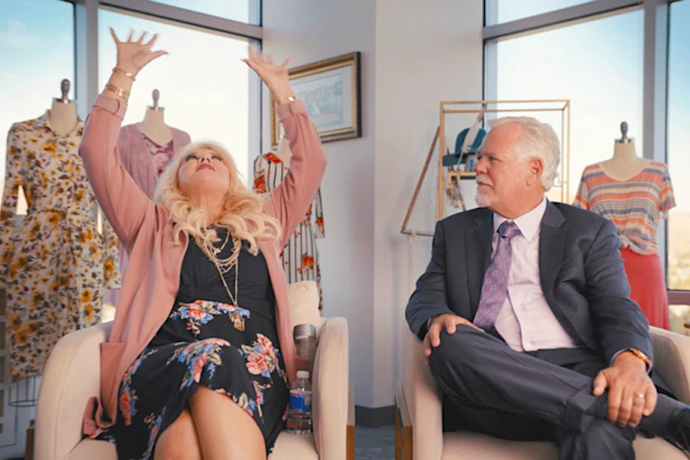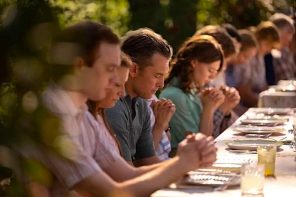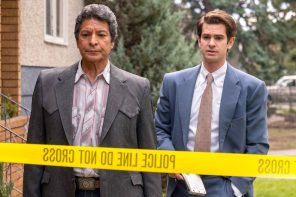Jana Reiss, a senior columnist for Religion News Service, recently surveyed a number of recent television programs that “present Mormonism in an unflattering light.” The column’s headline claims “Mormons are being oppressed and mocked on TV. We’re not alone.” Let’s review the tape.
Mocked? Maybe. If nothing else, Hulu’s Under the Banner of Heaven certainly made a mockery of my already-scant patience.
Oppressed? I don’t think that word means what you think it means.
Not alone? Indeed they are not. Nor should they be.
Shows like Under the Banner of Heaven, Keep Sweet, and Mormon No More certainly don’t make Mormonisms look good, but critique—however ham-fisted and ahistorical—is not oppression. (We’re talking about Mormonisms plural here because, you guessed it, there are a lot of different groups that call themselves Mormon.) And responses to religiously intolerant pop culture that fail to account for degrees of disenfranchisement among American minority religions, or for the damage done within and by those communities, are at best limited and at worst damaging to vulnerable religious communities.
Mocked?
It’s difficult to gauge the impact of television programs or other pop-culture treatments of American minority religions. (This is why my book, Abusing Religion, focuses on the legal outcomes of religiously intolerant media—laws are more easily assessed and analyzed than hearts and minds.) But when it comes to shaping our attitudes toward religious outsiders, pop culture’s impact is as inarguable as it is immeasurable.
I’ve argued extensively that pulp nonfiction, films, and television about minoritized religions directly inform Americans’ understandings and treatment of minoritized religious traditions, and very seldom for the better. By and large, popular treatments of non-mainstream, non-Christian, non-white, and/or non-male-led religious communities have been both unflattering and, as I show in my book, can inspire surveillance, harassment, and even state-sponsored violence toward those communities.
We should absolutely approach popular culture treatments of Mormonisms with a healthy dose of skepticism. Reiss rightly points out that programs like Keep Sweet, Mormon No More, and LuLaRich cast suspicion on and encourage hostility toward the Church of Jesus Christ of Latter-day Saints and its fundamentalist offshoots.
Anti-Mormon popular culture is almost as old as Mormonism itself. Much contemporary anti-Mormon media draws on historical anti-Mormon tropes. For example, Under the Banner of Heaven suggests Dan Lafferty escaped the death penalty by exerting psychosexual influence over a female juror; Krakauer might as well have cut and pasted it from Trapped by the Mormons (1922), a.k.a. The Mormon Peril, a silent film in which young British women are kidnapped and sent to become wives in Utah.

We should absolutely attend to how popular culture can contribute to and bolster religious intolerance, especially when such treatments compound historically shaky critique with white supremacy: Under the Banner of Heaven accurately depicts contemporary Mormon anti-Native attitudes, for example, but does little to correct pop culture imagining of contemporary Mormons as primarily or exclusively white.
Banner, Mormon No More, and similar offerings certainly deserve criticism for prioritizing provocation and scandal, but if we’re concerned with oppression, we’d do better to attend to their religio-racism than their failure to flatter.
Oppressed
And there’s the rub: doing a clumsy, ahistorical, even mind-numbingly dull job of critiquing Mormonisms is not the same thing as oppressing or persecuting Mormons—though claiming religious persecution is a time-tested strategy for minority traditions manifesting their American-ness, so I’m not mad at the attempt. But the truth is that, in what’s now the United States, no one is oppressing the Church of Jesus Christ of Latter-day Saints or its members on the basis of religion. Critique, scrutiny, and mockery aren’t flattery, but neither are they oppression.
Oppression is systemic. The systems America has in place haven’t prevented the LDS Church or its members from flourishing politically, economically, educationally, geographically, or legally because they are Mormon. In fact, the LDS Church uses its considerable resources to shape the American political landscape according to its own understanding of gendered sexual morality, much like the Roman Catholic Church does. And much like the Roman Catholic Church, the Church of Jesus Christ of Latter-day Saints has been concealing and facilitating the sexual abuse of children and other vulnerable church members for years. The Mormon Church, like the Roman Catholic Church, has fought its way into the mainstream, bettered its cultural standing, and expanded its political influence by doubling down on white supremacy, misogyny, and homophobia.
It’s important to clarify that not all Mormons are members of the Church of Jesus Christ of Latter-day Saints, and that Mormon fundamentalists absolutely are oppressed on the basis of religion and the religiosexual practice of polygyny. That oppression allows abuse to flourish, isolating vulnerable members of Mormon fundamentalist communities and making it harder for them to get help or leave abusive situations.
And this is where I take issue with shows like Under the Banner of Heaven and Keep Sweet: not with their awkward and occasionally somnolence-producing attempts to unflatter Mormonism (or even their inelegant inquiries into “what if religious freedom, but too much?”), but with their reliance on presenting polygyny exclusively as abuse and offering religiosexual difference as the root cause of that abuse. Popular culture treatments too often make a spectacle of religious sex abuse while doing little if anything to address or disrupt the root causes.
Not Alone
Religion doesn’t cause abuse, no matter what Under the Banner of Heaven wants you to believe. At the same time, powerful religious institutions often allow abuse to flourish while denying its all-too-frequent occurrence. Religious institutions like the Church of Jesus Christ of Latter-day Saints can accrue such power because the US Constitution protects “religion,” most often read as “specific forms of cishet white mainstream Christianity”—though other kinds are allowed so long as they don’t get carried away and expect their practices or theologies to supersede the former (the jurisprudential equivalent of know your role and shut your mouth). Americans have a right and a duty to scrutinize religious institutions that endanger vulnerable people and make it harder to be religiously, sexually, or otherwise Otherwise in this country.
Popular media is one of many ways the general public—as well as former and current members of the religious traditions in question—subjects religious practices, communities, and institutions to scrutiny. Indeed, many practicing and former Mormons seem to, if not like, at least appreciate Hulu’s Under the Banner of Heaven series for raising questions about how the Church teaches its own history.
(I’m shocked that anyone made it through the series at all, to be honest. That this show manages to make murder, Mormonism, and Andrew Garfield so utterly soporific is the real True Crime.) I did not like Banner, for reasons both related and unrelated to why I expected not to like it, but I can appreciate that the critique the series presents might hold value for some.
It’s worth noting that Mormons, fundamentalist or otherwise, are by no means unique in receiving this kind of public scrutiny through popular culture. Reiss points out that evangelicals, Orthodox Jews, and Catholics have not escaped the SHOCKING TRUE STORY treatment—though her omission of Muslims from this list should give us pause, given how often they and other minoritized religions receive short shrift in American popular culture. (See, for example, the multiseason Islamophobic trainwreck that was Homeland, or even the ways Master of None encouraged viewers to sympathize with Ansari as Muslim, but not too Muslim.)
If we’re to attend to religiously intolerant programming, we ought to attend most closely to depictions that endanger members of marginal religions. Popular culture depictions of minoritized religious communities can and do damage those communities; while we’re increasingly seeing positive, nuanced on-screen portrayals of Muslims (from We Are Lady Parts to Midnight Mass), the vast majority of US media treatments of Muslims and Islam have reinforced, bolstered, and even celebrated the legal and cultural oppression of Muslims on the basis of both religion and race.
Television is neither the cause of nor solution to all life’s problems, but it can and does drive popular understandings of and responses to American minority religions. By all means, let’s critique media that perpetuates religious intolerance—but let’s also remember that critique is not oppression and that scrutiny without consequence is empty.
I’m not convinced that programming like Keep Sweet or Mormon No More can or will do much to confront or disrupt the complexities of abuse—religious or otherwise. (Though if a boring-ass series on tax evasion inspires more scrutiny of spaces where abuse has been allowed to flourish: so be it.) But let’s at least take care to discriminate between media that’s unflattering and media that does harm to vulnerable communities.





